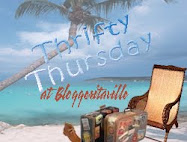Hi again, Everyone!
As when my thrifted flatware post (HERE) was discovered by Goodwill and mentioned on their Facebook page ... and Google's "Blogs of Note" found Affordable Accoutrements and offered their kind endorsement ... well, I've been "caught" once again! A member of the Association for the Preservation of Tennessee Antiquities read my series of posts about Historic Bolivar, Tennessee, and contacted me. The other posts are HERE, HERE, HERE, and HERE, if you'd like to read more.
I omitted some information the Association wishes readers to know and repeated a few historical inaccuracies gleaned from online searches. I apologize for that to you and to the Association.
Here's her e-mail (no last names!):
Bill,
I love your "tours"! Your photography is original, artistic and wonderful! Unlike the comments on the blog, I do have a but ...
First: re McNeal Place, EP McNeal was grandson of Ezekiel Polk (Grandfather of President James K. Polk.) So EP (Ezekiel Polk McNeal) was cousin to the president.
EP was brother to Prudence Tate (McNeal) Bills, first wife of John Houston Bills of The Pillars.
Second: you may be interested to know that the "little barn" at the Fentress Black House/Baker Estate Sale was a milking stall. Aileen Baker (who owned the property and died in May) told me that last year when I visited her.
Next and most important: Our APTA Group would love it if you would annotate your blog photos of The Little Courthouse (LCH) that the Little Courthouse Museum is open the second and fourth Saturday every month between the hours of 10:00 a.m. and 2:00 p.m. and by appointment. We have a web site thepillars.org for both The Pillars and the LCH.
The Pillars is open on the Spring Home Tour and available by appointment and for event rentals. Our phone number is (731) 528-7148, and the web site is also thepillars.org.
Additionally, the US Post Office in Bolivar Circa 1940s has a delightful original mural by Carl Nyquist titled "Picking Cotton" that is 13 ½’ wide by 3’ high. It can be seen 24/7 due to the PO Box access. It is thought to be a late WPA commission.
Lastly, when the LUEZ Theater was offered money to paint the rusty marquee, the owner said "no thanks, that marquee is porcelain" so the rust marks will stay.
Keep up the great work!
Paula S.,
Member of The Association for the Preservation of Tennessee Antiquities.
----------------------------------------------------------------------
Most of the historic sites Ms. Paula mentioned are described in the following post from September, 2009. However, her comments also refer to sites in other posts in the series (the first and third HERE's listed above).
The tour begins:
In yesterday's post, I took you along to an estate sale in an antebellum home in Bolivar, Tennessee. At the end, I asked if you would be interested in seeing more of the historic places in this West Tennessee town (population 5,802). Based on the positive response (I was hoping you'd say yes!), the tour continues. Part 2 focuses on sites related to the Civil War.
The first photograph is of the Presbyterian Church, the oldest church structure in Bolivar. It was built in 1852 and contains most of its original furnishings. It's noted for the pipe organ that was added in the late 1800s. During the War Between the States, the church was a place of worship for troops from both sides.
This shows the church's location relative to Hardeman County's first courthouse (the white frame structure on the right).
The Little Courthouse, which was Hardeman County's original courthouse, was built in 1824, used for two years, and then moved to its present site just off the square in 1827. The log structure became the nucleus of a home for the Levi Joy family. Next, a Judge Barry purchased the log building/house. In 1849, his widow sold the house to Dr. Thomas E. Moore. Dr. Moore made extensive additions including painted weatherboard siding, shutters, and additional rooms. His family resided in the house for over 100 years. The descendants of his granddaughter, Miss Jennie Hardaway, sold the house to the county in 1967. One of only three log courthouses left standing in the United States, it now serves as the county's museum.
The second courthouse was burned in 1864. Union General Samuel D. Sturgis ordered that Bolivar be razed as his forces moved toward LaGrange, Tennessee. Citizens were given time to remove records and artifacts, which were stored until the third (and present) county courthouse was built on the original site in 1869.
The Little Courthouse reminds me of buildings in Colonial Williamsburg.


It's listed on the National Register of Historic Places.
Another view ...
The yellow house in the distance was saved from demolition by being moved to its present location. I'll show you a closer view of it in an upcoming tour.
“The Pillars” was home to the politically and socially prominent Bills family.
Major John Houston Bills came to West Tennessee in 1818 with members of the family of James K. Polk. In 1823, Bills married Prudence Polk McNeal, a cousin of the future president.

The house once accommodated such notable guests as Andrew Jackson, Davy Crockett, Sam Houston, James K. Polk, and Jefferson Davis. The Pillars served as a hospital twice during the Civil War, alternately providing care for men on both sides of the conflict.
 The house underwent numerous expansions and renovations, one of which changed its orientation to face a different street. A tour guide told us that, during one of the renovation projects, the home’s owner returned from a trip to find that workmen had installed the columns (that give the home its name) upside-down. They were left that way, and I think it adds interest to this unique property. The Bills family traveled extensively and included a number of prolific artists. Original furnishings, personal belongings, and artwork remain in the home for visitors to see.
The house underwent numerous expansions and renovations, one of which changed its orientation to face a different street. A tour guide told us that, during one of the renovation projects, the home’s owner returned from a trip to find that workmen had installed the columns (that give the home its name) upside-down. They were left that way, and I think it adds interest to this unique property. The Bills family traveled extensively and included a number of prolific artists. Original furnishings, personal belongings, and artwork remain in the home for visitors to see.
This Greek revival home, "The Columns," was built in 1860. It served as a makeshift hospital for sick and wounded soldiers during the Civil War.
 A walled garden is one of many appealing features of this historic property.
A walled garden is one of many appealing features of this historic property.
The house reflects the life of the Ingrams, an affluent banking and merchant family who bought it around 1900 and filled it with furnishings in the late-Victorian style.

Extensive restorations are ongoing at the house, which was deeded to the Bolivar Historical Foundation, Inc., established by The Columns’ last resident, Elizabeth Ingram, before she died in 1995. She was just two months shy of her 102nd birthday!



The fences hint at the beauty in store ...
From the street corner ....
The home is unique in that it was not designed by a local architect or built locally. It is believed that the architect was Samuel Sloan of Philadelphia. The lumber was pre-cut and delivered on barges from Cincinnati, Ohio. The shipping stencils are still evident on the back porch latticework and the cooks quarters’ mantle. Some of the features and materials used were imported from Europe.
The entry hall frescoes, marble and granite, and graining on the interior woodwork feature craftsmanship unknown in West Tennessee homes of the time. Furnishings and paintings are original to the McNeal family and their heirs, the Hills and McDonnells. Several outbuildings and elements of the original landscaping remain.
Their website mentions that “each brick was hand-made and sun-dried on the home site by slaves.” It's a sad reminder that the lifestyle these fine old homes represent was created through, and supported by, the institution of slavery.
In 1862, during the Civil War, Magnolia Manor (home of the Miller family) was occupied by the Union Army and used as headquarters. Four Union generals, including Grant and Sherman, stayed there. Mrs. Miller told the Generals they could "only use half of the house" as she was "a delicate woman." The home has been featured in National Geographic Magazine and on HGTV’s “If Walls Could Talk.”
That's it for today. I hope you enjoyed the tour.
























What a wonderful tour Bill. I love McNeal Place, what a gorgeous home. And I love the Magnolia Manor story about the Generals. They may have been strong military men, but I bet they didn't cross Mrs. Miller! Congratulations on all of the notice you are receiving, it's so well deserved! Have a wonderful week. Kathy
ReplyDeleteCongradulations for your acknowledgements! What a wonderful, historical post. I have never visited any of these places, but I feel like I am strolling down the streets with you. So lovely and informative. Please continue to bring us other points of interest. I too love to post "field trips". Yours are guided to perfection!
ReplyDeleteYvonne
What a wonderful post! Thanks for the tour as I may never actually visit any of these places. So much history! Thanks for sharing. -Delores
ReplyDeleteA wonderful tour Bill! I love seeing and touring old/historic areas and buildings especially old churches and graveyards, too. Beautiful photos!!
ReplyDeleteSplendid cyber tour of historic buildings. Information was interesting.
ReplyDeleteJoyce M
Hi Bill,
ReplyDeleteI loved the tour! I love everything to do with big old houses, history and more! My hubby and I were recently reading up about places to live with low cost of living and Tennessee was in the top 5. Sounds good to me! I am going to add to your followers again as I am still not always getting updates! Yikes, that blogger can be annoying! Cindy
Great photos and thanks for the tour. I enjoyed reading about the history of the beautiful buildings/homes. You obviously put a lot of time and work in your posts, not only photographing but also the research involved.
ReplyDeleteVery nice neighborhood!
ReplyDeleteTunnels in Korea
I see the note about the post office mural; we have a 1941 mural in our little town's post office, too. I recently learned more about this series of murals, and it's interesting to see that preservation.
ReplyDeleteHi, Bill and congratulations all all your recognization. I am so proud that others see how talented you are in so many ways and address the issue.
ReplyDeleteThis is an amazing post with so much beauty and information...I can see why your blog was chosen for such fine acknowledgements!
GREAT JOB, my friend.
xo bj
Great post! Beautiful pictures.
ReplyDeleteYes congratulations! The homes and and churches are beautiful! I would love to visit there someday. Thank you for sharing!
ReplyDeleteThis was a wonderful tour Bill! I always enjoy learning about historical locations homes and churches. The antebellum mansions of the South are fascinating! I was lucky enough to tour some along River Road in Louisiana on a trip to New Orleans a few years ago.
ReplyDeleteCongratulations on all your well deserved recognitions!
great post
ReplyDeleteJust a point, the Presbyterian Church has very new pews, squarish, replacing the second set of curved pews which were used during the 1950s and 60s and probably earlier than that. Also, it was used as a hospital during the Civil War as well as a place of worship, notably by Gen. Lew Wallace, who wrote Ben Hur.
ReplyDeleteI loved seeing all of the history! My family was the one that moved the yellow house behind the church. They bought it from the bank and named it Ashley Hall.
ReplyDelete